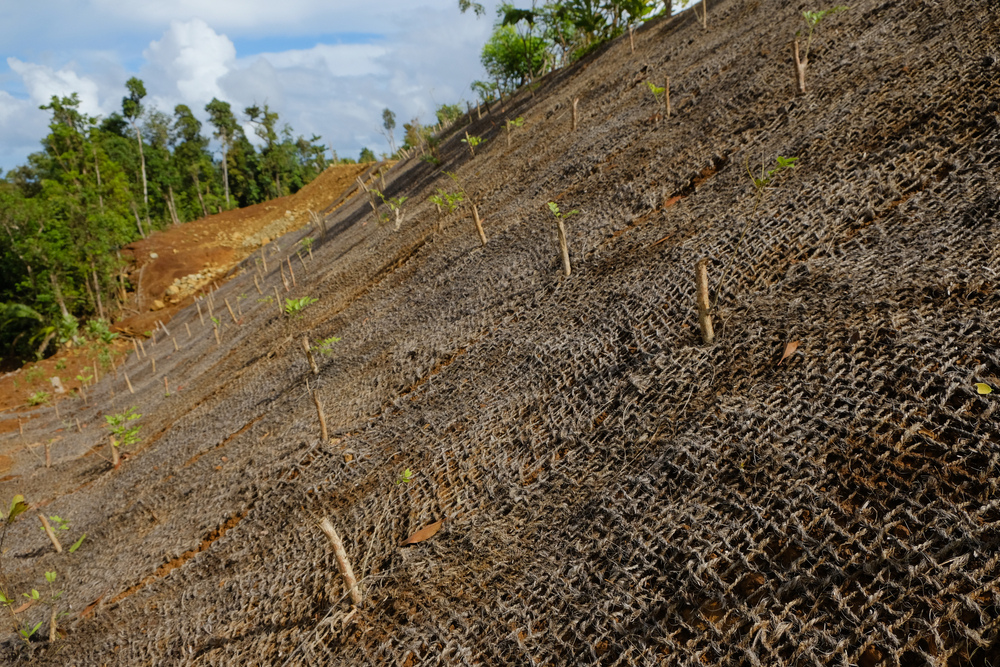Introduction
Erosion control is a critical aspect of maintaining the stability of landscapes and ecosystems. Whether it’s safeguarding agricultural fields, preventing landslides, or protecting coastal areas, managing soil erosion is vital for preserving environmental health and ensuring sustainable development.
In recent years, the focus has shifted toward sustainable solutions, and jute netting has emerged as an eco-friendly and effective method for combating soil erosion. In this article, we’ll explore how jute netting for erosion control works, its benefits, and why it’s an ideal choice for slope stabilization and other erosion-related challenges.

What Is Jute Netting?
Jute netting is a biodegradable fabric made from the natural fibers of the jute plant. This netting is lightweight, flexible, and easy to handle, making it an ideal material for various erosion control applications. Unlike synthetic alternatives, jute netting decomposes over time, enriching the soil with organic matter as it breaks down.
Its primary role in erosion control is to stabilize soil, reduce runoff, and create an environment conducive to vegetation growth. This not only helps prevent soil loss but also promotes long-term environmental sustainability.
Benefits of Jute Netting for Erosion Control
- Eco-Friendliness:
Jute netting is entirely biodegradable and made from renewable resources, making it a sustainable alternative to plastic or synthetic materials. It aligns with global efforts to reduce environmental impact and combat climate change. - Erosion Prevention:
When installed on slopes or exposed areas, jute netting holds soil particles in place, preventing them from being washed away by water or wind. This is especially critical for regions prone to heavy rainfall or strong winds. - Soil Health Improvement:
As the netting decomposes, it releases organic nutrients into the soil, enhancing its fertility. This natural process supports vegetation growth and helps restore degraded lands. - Cost-Effectiveness:
Compared to synthetic erosion control materials, jute netting is relatively affordable and readily available, making it an accessible solution for projects of all sizes.
Applications of Jute Netting
- Slope Stabilization in Construction Projects:
Jute netting is commonly used on construction sites to stabilize slopes and prevent soil erosion. It provides immediate protection while vegetation establishes itself. - Reclamation of Degraded Lands:
In areas affected by deforestation or overgrazing, jute netting helps restore soil stability and encourages the growth of native plants. - Support for Vegetation Growth in Agricultural Areas:
Farmers use jute netting to prevent soil loss, especially in hilly regions or areas prone to heavy rains. It also serves as a protective layer for newly planted seeds. - Prevention of Soil Erosion in Coastal Regions:
Coastal erosion is a growing concern, and jute netting offers a sustainable solution for protecting beaches, dunes, and riverbanks from erosion caused by tides and currents.
How to Install Jute Netting
Installing jute netting is straightforward and requires minimal expertise. Here’s a step-by-step guide:
- Assess the Area:
Begin by evaluating the site to determine the extent of erosion and the area to be covered. Clear the surface of debris and level the ground if necessary. - Prepare the Surface:
If vegetation growth is part of the plan, seed the area before laying the netting. - Lay the Jute Netting:
Unroll the jute netting and lay it evenly across the surface. Ensure it covers the area entirely without leaving gaps. - Secure the Netting:
Use wooden or metal stakes to anchor the netting securely into the ground. Place stakes at regular intervals to prevent movement. - Combine with Vegetation:
For optimal results, use jute netting in combination with plant seeds or seedlings. As the plants grow, their roots will anchor the soil further, enhancing the long-term stability of the area.
Conclusion
Jute netting is more than just a tool for erosion control—it’s a step toward sustainable land management and environmental conservation. Its natural, biodegradable properties make it an eco-friendly choice for preventing soil loss, stabilizing slopes, and fostering vegetation growth.
If you’re seeking a cost-effective, environmentally conscious solution for erosion control, jute netting is the perfect choice. Embrace the natural power of jute and make a lasting impact on your project and the planet.
Take action today! Explore how jute netting can meet your erosion control needs and ensure the stability of your land. Reach out to a local supplier or contact us for more information on sustainable solutions.








